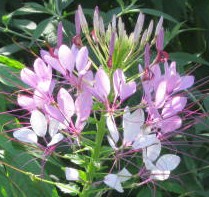 Spider flower is an annual native to southern South America but grown widely in the US for the large unusual flowerheads that feature long stamens that give a spider web look, and the long dangling seed pods that look like spider legs. The flowers are cross pollinated by insects so if you want pure strains for seed saving, grow one variety at a time. The flower color is variable from white to pink or pale purple and hybrids such as the Sparkler series will produce variable off spring. The Queen series, however is open pollinated. All spider plants heavily self-sow.
Spider flower is an annual native to southern South America but grown widely in the US for the large unusual flowerheads that feature long stamens that give a spider web look, and the long dangling seed pods that look like spider legs. The flowers are cross pollinated by insects so if you want pure strains for seed saving, grow one variety at a time. The flower color is variable from white to pink or pale purple and hybrids such as the Sparkler series will produce variable off spring. The Queen series, however is open pollinated. All spider plants heavily self-sow.
Spider flower is a warm weather plant and blooms all summer till frost in most climates but may become bedraggled by late summer in warm climates. Seed pods are long and thin and produced all along the stems as they grow and producing more flowerheads at their tips.
Directions for Collecting Seed:
1. As the flowers fade on the stem watch the development of the seed pods. They will first be green but will turn yellow and then brown.
2. When the seed pods are brown and dry snip them off but don’t wait too long as the pods will split open and throw the seeds all over the ground. Spider flower produces an abundance of seed pods carryng numerous seeds so don’t be concerned if some pods open before you collect them; pods are produced over a long period of time.
3. Open the pods and remove the seeds.
4. Dry the seeds on paper toweling or newspaper in a dry place where temperatures are warm but below 90 F. Depending on the humidity and ventilation, the seeds will probably need at least a week to dry.
5. Store in an airtight container like a small glass jar and place in a cool, dark place. The refrigerator is ideal. The seed viability of spider flower is short so plant seeds promptly in spring.